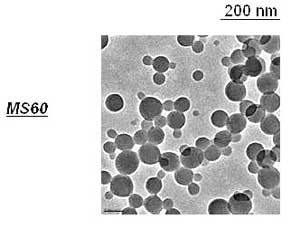| Feb 02, 2006 |
New testing method to assess safety, health risks of nanomaterials
|
|
(Nanowerk News) UCLA has developed a new testing method that would help manufacturers monitor and test the safety and health risks of engineered nanomaterials. Currently, no government or industry regulations exist for this emerging technology.
|
|
A review article in the Feb. 3 issue of the journal Science by Dr. Andre Nel, professor of medicine at the David Geffen School of Medicine at UCLA and a member of the California NanoSystems Institute, presents a compelling discussion on the potential toxic effects of nanomaterials and the urgent need for developing safety testing.
|
|
The ability of nanotechnology to interact with biological materials leads to the possibility that they may be harmful to humans and the environment. Current understanding of the potential toxicity of nanoparticles is limited, but research indicates that some of these products may enter the human body and become toxic at the cellular level, in various body fluids, tissues and/or organs.
|
|
Recognizing a need to develop a rational, science-based approach to nanotoxicology, Nel and his UCLA team have developed a new testing method to assess the safety and health risks of engineered nanomaterials. Nel also is establishing NanoSafety Laboratories Inc. in association with the California NanoSystems Institute at UCLA to help manufacturers assess the safety and risk profiles of engineered nanomaterials.
|
|
The testing model developed at UCLA is based on toxicity testing for occupational and air pollution particles, which include nanoparticles. Nanoparticles are the most toxic ingredient in these environmental pollutants. A mature toxicological science has emerged from the study of these particles, providing a framework for a predictive testing strategy applicable to engineered nanomaterials.
|
 |
Positively charged polystyrene particles (a type of engineered nanoparticle) generate oxygen radicals and mitochondria damage in cells.(Source: UCLA)
|
|
A predictive strategy is one in which a series of simple but high-quality tests can be employed to predict which materials could be hazardous, and therefore speed up the process of classifying materials into those that are safe and those that could pose toxicity problems. This type of approach is similar to that used by the National Toxicology Program for evaluation of chemical agents.
|
|
Nel's model predicts toxicity according to the ability of some nanoparticles to generate toxic oxygen radicals, which are highly reactive forms of oxygen that can cause tissue injury, including inflammation and other toxic effects. For air pollution particles, this injury can translate into asthma and atherosclerotic heart disease. Using this model, Nel's laboratory has developed a series of tests to assess nanoparticle toxicity in non-biological environments as well as in tissue cultures and animal models. "We can use the strong scientific foundation of air pollution particle testing to help understand the health impact of engineered nanoparticles and ensure safe manufacturing of nanoproducts," said Nel.
|
|
The review in Science addresses questions about occupational and inhalation exposures to nanoparticles and outlines the properties of nanomaterials that need to be considered for toxicity testing. The impact of nanoparticle interactions with the body is dependent on their size, chemical composition, surface structure, solubility, shape and how the individual nanoparticles amass together, according to Nel. Nanoparticles may modify the way cells behave and potential routes of exposure, include the gastrointestinal tract, skin and lungs. The three key elements of the toxicity screening strategy should include the physical and chemical characterization of nanomaterials, tissue cellular assays and animal studies.
"An understanding of nanotoxicity could also lead to the harnessing of their properties such as using nanoparticles that initiate cell death to be used for targeted chemotherapy approaches," said Nel.
|

